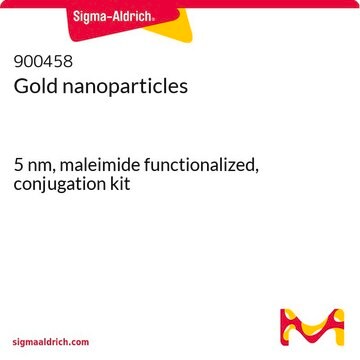765260
Gold nanoparticles
5 nm diameter, amine functionalized, PEG 3000 coated, OD 50, dispersion in H2O
Sinonimo/i:
Gold nanoparticles NH2 functionalized, Au NP NH2, Gold Colloid
About This Item
Prodotti consigliati
Materiali
PEG 3000
Forma fisica
dispersion in H2O
nanoparticles
Confezionamento
glass bottle of 1 mL
OD
50
Diametro
5 nm
pH
6.0-8.0 (25 °C)
Solubilità
water: miscible
Densità
1.00 g/cm3
λmax
515 nm
Gruppo funzionale
amine
Temperatura di conservazione
2-8°C
Cerchi prodotti simili? Visita Guida al confronto tra prodotti
Applicazioni
AuNPs can be potentially immobilized on antibodies to improve the sensitivity of optical fiber sensors for the screening of COVID-19. They can also be deposited on the titanium electrode for the formation of a miniaturized device for the electrochemical detection of DNA hybridization, which can be used in the diagnosis of COVID-19.
Caratteristiche e vantaggi
- Negatively charged siRNA-PEG complex which is attached to positively charged GNPs is easily cleavable in reductive cytosolic environment thus enabling the release of siRNA into cytosol.
- Decreases the cytotoxicity and increases efficiency of GNPs. PEG increases the stability of the nanoparticles and prevents agglomeration.
Codice della classe di stoccaggio
12 - Non Combustible Liquids
Classe di pericolosità dell'acqua (WGK)
WGK 1
Punto d’infiammabilità (°F)
Not applicable
Punto d’infiammabilità (°C)
Not applicable
Certificati d'analisi (COA)
Cerca il Certificati d'analisi (COA) digitando il numero di lotto/batch corrispondente. I numeri di lotto o di batch sono stampati sull'etichetta dei prodotti dopo la parola ‘Lotto’ o ‘Batch’.
Possiedi già questo prodotto?
I documenti relativi ai prodotti acquistati recentemente sono disponibili nell’Archivio dei documenti.
I clienti hanno visto anche
Articoli
The recent emergence of a number of highly functional nanomaterials has enabled new approaches to the understanding, diagnosis, and treatment of cancer.
Biomaterials science integrates smart materials into biological research, requiring a deep understanding of biological systems.
Il team dei nostri ricercatori vanta grande esperienza in tutte le aree della ricerca quali Life Science, scienza dei materiali, sintesi chimica, cromatografia, discipline analitiche, ecc..
Contatta l'Assistenza Tecnica.





